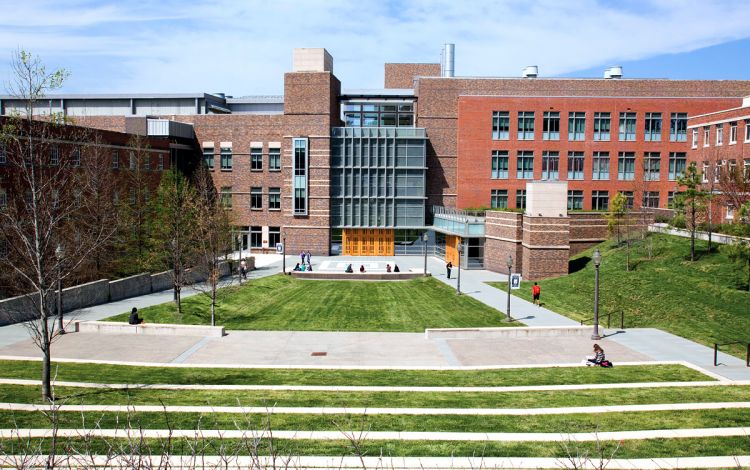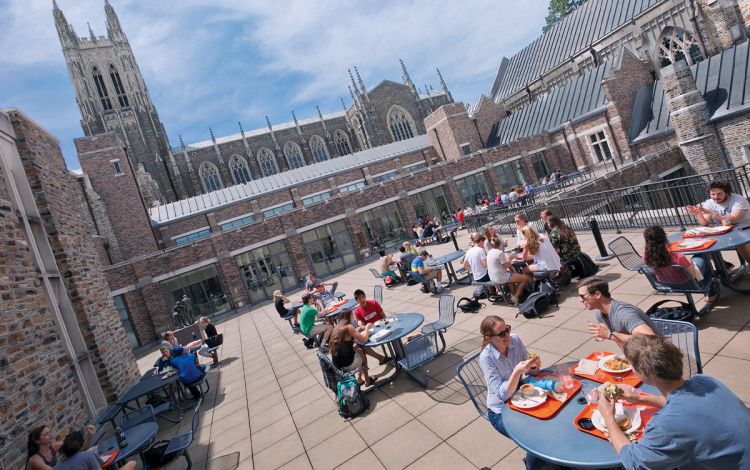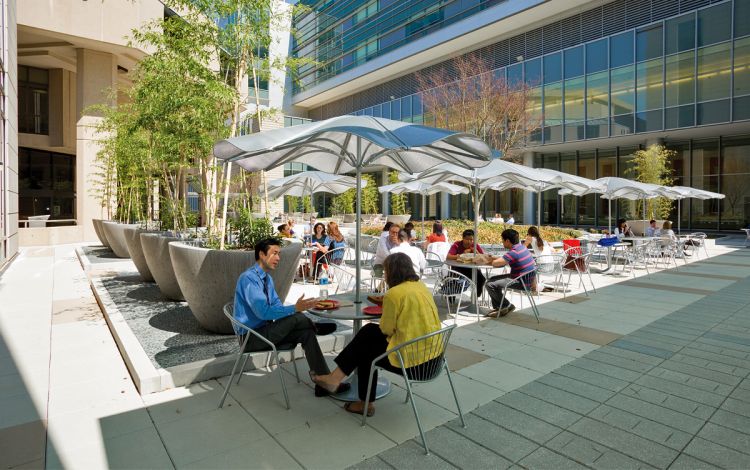Your Spring Guide to Outdoor Campus Spots
Duke’s ‘collection of memorable places’ includes beautiful spaces to work, enjoy lunch, take a break and more
Whenever Will Hanley visits Sarah P. Duke Gardens, he feels like he’s walked into an art exhibit curated by nature.
With 55 acres of specialized gardens in the heart of Duke University, the gardens bring Hanley a reprieve as he walks the paths with a camera in tow. Springtime, when cherry blossoms, tulips and bright flowers bloom, is one of Hanley’s favorite times in the gardens. As a volunteer photographer for the gardens, he has documented thousands of moments.
“It’s one of my favorite places on earth,” said Hanley, a Duke Libraries specialist who visits the gardens about once a week. “It’s a place where I can be content.”
The gardens is among the many places where Duke community members can enjoy a respite or get work done, too. Since a master plan for the campus was written in 2000, a guiding principle has steered landscape design: “Duke is a collection of memorable places.”
“We have probably 1,000 red buds on campus that all bloom at the same time across campus,” said Duke University Landscape Architect Mark Hough. “They become sort of this ribbon of spring flowers that connect the different parts of campus.”
With the first official day of spring having started on March 20, check out some scenic spaces to enjoy the new season.
French Family Science Center Amphitheater
 Later in her Duke undergraduate career, Samantha Votzke spent time bouncing between classes in the horseshoe formed by the French Family Science Center, Biological Sciences Building and Physics Building.
Later in her Duke undergraduate career, Samantha Votzke spent time bouncing between classes in the horseshoe formed by the French Family Science Center, Biological Sciences Building and Physics Building.
In the middle of that horseshoe sits the French Amphitheater, a green spot with grassy areas, shady trees and plenty of places to sit. As a student, Votzke often paused there to take a break, eat lunch or wait while her thesis advisor finished notes on her next draft with a red pen.
Now, as an associate in research in the Gibert Lab, the Amphitheater remains a special spot for her. Unless it’s pouring rain, Votzke walks down the stairs from the third floor with her gray lunch bag and sits on the ledge near the Physics Building sidewalk to eat.
Featuring Adirondack chairs, Wi-Fi, and plenty of space to sit, the spot is a good fit for nearly any activity.
"There’s a little bit of a nostalgia factor,” said Votzke, who recently marked her second year working at Duke. “But also, when you’re working in a lab, or any office space that requires a lot of hard focus and concentration, to have a little slice of green to come out to can really relax you and prepare you to concentrate again for the rest of the day.”
Duke Divinity School
 Just outside Zweli’s Café at Duke Divinity and the Divinity Bookshop, the outside the Duke Divinity School is a tucked away spot with an overhead view of Duke University Chapel.
Just outside Zweli’s Café at Duke Divinity and the Divinity Bookshop, the outside the Duke Divinity School is a tucked away spot with an overhead view of Duke University Chapel.
Since Ken Spencer joined Duke as the associate director of Rural Church Engagement, the terrace has been a nice quiet space to start his workday on Thursday mornings. Before meeting with students inside the café, Spencer sips on coffee from a navy-blue Yeti tumbler, watches the squirrels and catches up on email.
“I go out there and spend a little quiet time,” Spencer said. “It’s a neat spot on campus in the way it’s tucked around Telecom Drive. There’s really no traffic and not a whole lot of folks coming through.”
Around lunchtime, the outdoor seating area picks up as people enjoy Zimbabwean cuisine from Chef Zweli Williams. With about two dozen tables and chairs, a tent for shade and sunny spots, the outdoor area is quiet enough to catch up on work or a nice place to hold a meeting or enjoy a flavorful meal.
Trent Semans Center
 The Mary Duke Biddle Trent Semans Center for Medical Education, home of the Duke University School of Medicine, is surrounded by research buildings, Duke University Hospital and clinics. But the terraced plantings in front of the sleek glass and steel building offers a dose of calm and quiet.
The Mary Duke Biddle Trent Semans Center for Medical Education, home of the Duke University School of Medicine, is surrounded by research buildings, Duke University Hospital and clinics. But the terraced plantings in front of the sleek glass and steel building offers a dose of calm and quiet.
One of the initial goals of the space was to serve as a bio-retention area where stormwater runoff from the roofs and paved spaces of the surrounded facilities could be filtered through different kinds of soils, materials and plants.
But the area, with inviting benches, ledges and quiet alcoves, has become a space for students, staff, faculty and patients who pass through surrounding buildings to relax outdoors.
On a recent sunny day, Duke University School of Medicine student Nicholas Hastings was one of them. With around 90 minutes before a group-learning session, Hastings studied some materials while sitting on a cement ledge on one of the terraces.
“This is a nice place to soak up the sun,” Hastings said. “You’re close enough to pop into the Trent Semans Center but distant enough to feel like you’re in your own bubble. In the medical school, it’s not like on West Campus, we don’t have as many outdoor spaces, so it’s nice to have a spot like this.”
Duke Pond
 Created in 2015, Duke Pond was built to serve a range of purposes, including capturing runoff from a growing campus and holding water for use in the nearby Chiller Plant No. 2. But the campus community has grown to appreciate the 12-acre site most as a space for physical recreation and mental restoration.
Created in 2015, Duke Pond was built to serve a range of purposes, including capturing runoff from a growing campus and holding water for use in the nearby Chiller Plant No. 2. But the campus community has grown to appreciate the 12-acre site most as a space for physical recreation and mental restoration.
With a trail that rings the pond and several areas where visitors can sit in and enjoy the surroundings, it’s a popular spot for students, staff and faculty to take a break.
Duke University Landscape Architect Mark Hough oversaw the design of the pond, which has won awards for its landscape architecture, and said the idea was to create a place of bio-diversity, beauty and functionality.
“It is, without a doubt, one of the projects I am most proud of in my time at Duke,” Hough said. “I go over there several times a week with my dog and am always thrilled when I see students and other people using it for running, walking, studying or hanging out.”
Derrick Family Terrace
Welcoming its first students in 2021, the Wilkinson Engineering Building is one of the newest facilities on campus. While the pandemic slowed the flow of foot traffic in the building, the Derrick Family Terrace on the western corner of the building is worth a walk over.
The outdoor patio has plenty of tables and views on two sides, including an eye-level perspective of Duke University Chapel.
Pratt School of Engineering Senior Communications Specialist Miranda Volborth recalled a lunch during the summer of 2021 celebrating artist Brendan Monroe, who was working on a mural for the building. The event was held on the Derrick Family Terrace, where gentle breezes cooled participants and stunning campus views provided a gorgeous backdrop.
“It feels like you’re almost on the deck of a ship,” Volborth said. “Sometimes you’ve got this breeze coming through and the blue skies. You can watch the weather roll through and just feel like you’re out in the elements, but you’re still comfortable.”
East Campus Lawns
As the original home to Duke University, formerly Trinity College, the most familiar parts of East Campus feature Georgian Revival buildings set in an orderly quad. On the margins of East Campus, sprawling oak trees shade rolling lawns, creating one of the most inviting, and perhaps underrated, parts of campus.
Ringed by a popular walking trail and featuring “The Sower,” a bronze statue honoring the agrarian roots of the Duke family, and the stone Stagg Pavilion, these lawns look largely as they did in the institution’s earliest days. And with Adirondack chairs scattered around the lawns, community members can grab a seat and enjoy some quiet time away from the busy pace.
“The area between Main Street and the buildings on East creates a very distinct edge for that campus,” Hough said. “It’s gorgeous.”
Got a favorite outdoor campus spot? Send a photograph through our story idea form or write working@duke.edu.